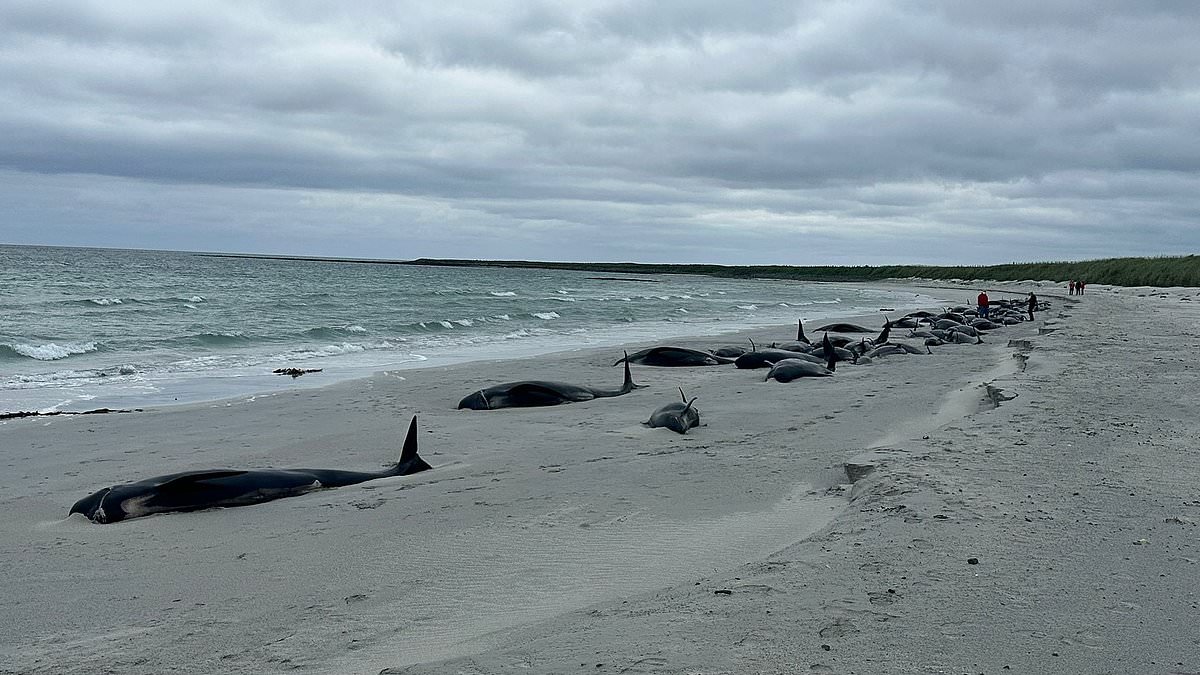This week Scotland suffered one of its worst strandings of whales after 77 of them washed up on a beach on one of the Orkney islands.
Questions have been raised as nearly all of the pilot whales found lying on Tresness Beach, on the island of Sanday this morning were found dead.
Just 12 of the huge long-finned mammals were discovered still alive four hours later.
Hopes of saving the animals were fading, with the whales thought to have been out of the water overnight.
Whale strandings are becoming an increasingly common sight on coastlines around the world, including on Britain’s beaches.
Up to 600 whales and dolphins wash on the UK’s shores alone, and experts are still unsure of the exact reasons for the epidemics.
A report compiled by UK Cetacean Strandings Investigation Programme (CSIP) on behalf of the government found there were nearly 5,000 whale and dolphin strandings in the UK between 2011 and 2017.
The most common species found on beaches were harbour porpoises and short-beaked common dolphins.
A pod of 55 pilot wales were stranded on the isle of Lewis in Scotland in July last year.
Further south in North Berwick, a minke whale became a tourist attraction after beaching near a nature reserve.
And a sperm whale turned up on a beach in Cleethorpes, Lincolnshire in April 2023.
In east Yorkshire a huge 55ft, 30 tonne fin whale turned up on Bridlington beach in May 2023, days after being spotted getting into difficulties in the sea.
Factors thought to be behind the strandings include poor weather, which can confuse an animal’s sense of direction, and diseases.
Bad conditions can send whales into dangerously shallow waters, leaving them at risk of drying up on the shore.
Local authorities have several options available to them to remove dead beached whales.
The animals can be taken to laboratories to be post-mortemed. Their skeletons are often collected by museums.
Some councils choose to send them to landfill or to be partially incinerated.
Depending on the location and size of the animal, some whales can be re-floated if still alive.
Even if dead, nutrients from the flesh are valuable to the ocean ecosystem if returned to the sea.
Finally, whales can be even buried on the beach or in remote areas left to decompose.
Evidence also points to human contributed causes, such as sonar and loud sounds used on military and surveying vessels.
The activity can scare the majestic creatures to the surface and even cause them to suffer from narcosis, a state of unconsciousness or numbness which can also be experienced by divers exploring at great depths.
Toxic chemicals found in the world’s oceans can harm marine animals, particularly those at the top of the food chain such as whales which are more likely to ingest them.
Fire retardants, pesticides and heavy metals all weaken whales’ immune system which in turn increases the likelihood of beaching.
Some substances such as plastics from human waste are especially harmful because they can be ingested but not digested properly.
A whale was discovered on the coast of Spain with over a hundred plastic bags in its stomach.
Polychlorinated biphenyls (PCBs), highly carcinogenic chemical compounds used in industrial and consumer products, also pose a risk to whales, the CSIP report found.
Because of their intense loyalty, pilot whales are likely to follow each other if one sick animal heads to the shore, potentially putting many in danger.
Bycatch, where fishermen accidentally extract whales while catching regular fish, is also a contributing factor to strandings.
The Orkney incident is believed to have been the largest of its kind in Scotland since 1995.
When whales are found beached alive, an assessment is made to see if they can be re-floated in the water.
In the event they cannot be saved, they are usually euthanised.
Dr Andrew Brownlow, the director of the Scottish Marine Animal Stranding Scheme, said that dead whales had to be removed from beaches swiftly to avoid causing distress to people and before they leak grease and bodily fluids.
The SMASS conducts post-mortems of carcasses at its laboratory. Their skeletons are often added to the collection at the Museum of Scotland.
But it’s equally important to return the nutrients of carcasses to the ocean, he told the BBC.
Local authorities can also choose to dispose of whales at landfill sites, send them for partial incineration or even bury them on the beach.
